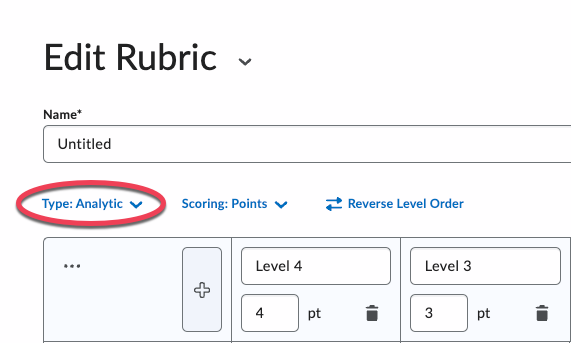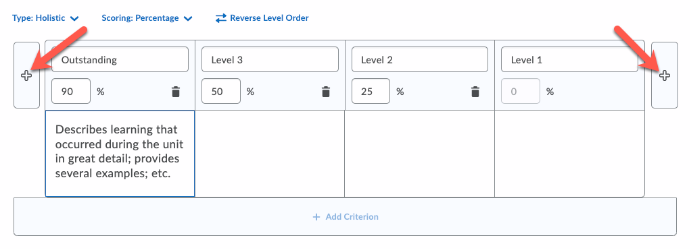What are Rubrics?
Rubrics are an assessment tool used to evaluate activities based on a predefined set of criteria.
To access the Rubrics tool, select the Course Admin link on the Navbar. Then select Rubrics under the Assessment header.
Why Should I Use A Rubric?
Rubrics provide a clear, consistent, and objective framework for assessing student work. Rubrics enhance transparency by outlining specific criteria and performance expectations, which helps students understand what is required to achieve various levels of performance. They also promote fairness in grading, reduce subjectivity, and provide valuable feedback that can guide student improvement. Additionally, rubrics save time for instructors by streamlining the grading process and can be used as a tool to support learning outcomes and course objectives alignment.
How Do I Create an Analytic Rubric?
An analytic rubric describes levels of performance by defining criteria. The performance levels in an analytic rubric can communicate expectations and detailed feedback to participants. The levels allow for consistent and objective assessment.
Step 1
In the Rubrics tool, select New Rubric.
Step 2
Enter a Name for the rubric.
Step 3
Analytic is the default type. Once you save your rubric, you will not be able to change the rubric type.

Step 4
Select Scoring: (Points is the default): to select how you want to assess the rubric.
- Points: Levels use text and point values such as "Excellent (100 points)" "Fair (75 points)." Point values are the same across criteria.
- Custom Points: Points given for each criterion can be customized. For example, the "Content" of the assignment might be worth 10 of the available points, while "Spelling and Grammar" might only be worth 5.
- No Score: Levels are indicated by text only, such as "Excellent," "Fair," and "Poor.”
Step 5
The rubric contains four Levels by default. Change the names and point values of the Levels by selecting the text boxes. To add new Levels, select the Add new level button (plus sign) to the left (before the current columns) or the right (after the current columns) of the existing Levels.

Step 6
Select inside each text box under each Level to provide a detailed description of that level of achievement. Leave default feedback for each Level of a Criterion in the Initial Feedback text box.

Step 7
To remove Levels, select the trash-can icon at the top of the Level column you want to delete.
Step 8
The rubric contains three Criteria by default. You can change the names of each criterion by selecting on the text boxes. To add new Criteria, select the + Add Criterion link at the bottom. To copy an existing Criterion, select the three dots next to its name and select Copy Row.
Step 9
To remove Criteria, select the Actions for Criterion (3 dots next to the Criterion) and select Delete Row.

Step 10
If you need to assess various aspects of an assignment separately with a different set of criteria, such as grammar usage or writing style, you can add another Criteria Group. Each Criteria Group can include different descriptions and point values. To add the new group, select the Add Criteria Group button.

Step 11
The Overall Score section totals the scores earned on each Level for each Criterion. You do not need to change anything about the Overall Score section, but if you'd like, you can customize the names and point ranges of these levels by selecting the text boxes
Important:
Do not delete the levels in Overall Score as the rubric will not function properly without them.
Step 12
Select the Options menu to customize the visibility and other details of this rubric.
- Rubric Visibility: Choose whether students can view the rubric before they complete or submit the activity.
- Learning Outcomes: Choose to automatically or manually map achievement to the levels in your rubric.
- Score Visibility: Choose whether students can see their scores in the rubric
Step 13
Select Close when you are finished working on the rubric.
How Do I Create a Holistic Rubric?
Holistic rubrics use one overall score to assess an assignment as a whole.
Note: The Add Criterion button is unavailable while creating a Holistic rubric, as this rubric is not criteria-based. If you intend to use a set of criteria, see the instructions in Creating an Analytical rubric above.
Step 1
Select New Rubric.
Step 2
Enter a Name for your rubric.
Step 3
Select Type and select Holistic. Once you save your rubric, you will not be able to change the rubric type.
Step 4
Select Scoring to select how you'd like to assess the rubric.
- Percentage: Assign a percentage to the Level that students achieve in the rubric
- No Score: Performance levels are indicated by text only, such as “Excellent” and “Fair.” Participants see no numerical value associated with performance levels.

Step 5
To add new Levels, select the Add new level button (plus sign) to the left (before the current columns) or the right (after the current columns) of the existing Levels.

Step 6
To change the name and percentage values (if using a percentage Scoring system), select inside the text boxes. Add a description of the level of achievement by selecting the text box under each Level.
Step 7
To remove Levels, select the Remove Level icon (trashcan icon) on the Level you want to delete.
Step 8
Select the Options menu to customize the visibility and other details of this rubric.
- Rubric Visibility: Choose whether students can view the rubric before they complete or submit the activity.
- Learning Outcomes: Choose to automatically or manually map achievement to the levels in your rubric.
- Score Visibility: Choose whether students can see their scores in the rubric
Step 9
Select Close when you are finished with the rubric.